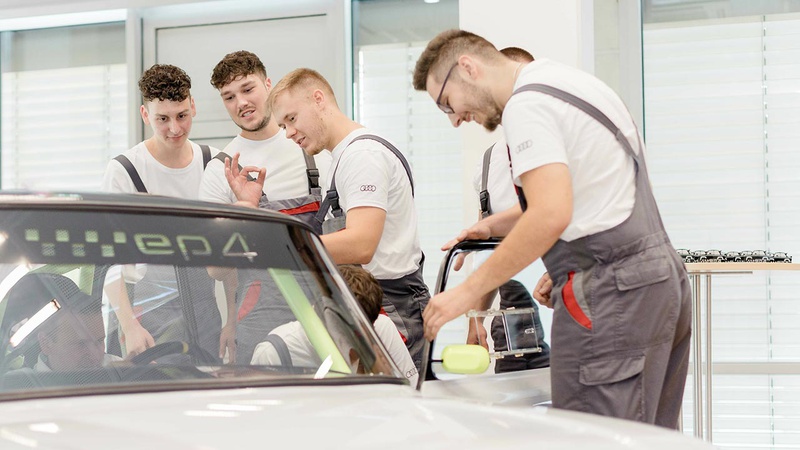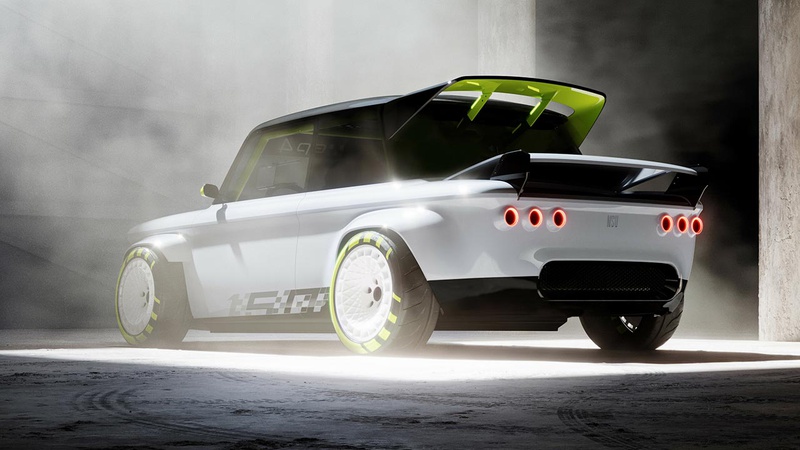To mark the 150th anniversary at the Audi site in Neckarsulm, twelve apprentices at the Four Rings electrified an iconic classic car. On July 8, trainees from the automotive mechatronics, bodywork, and vehicle construction mechanics and painting courses proudly unveiled the "EP4”. The "E" stands for electric drive, and the "P4" for the NSU Prinz 4, a model produced in Neckarsulm by NSU Motorenwerke from 1961 to 1973.
"We wanted to build a car that was not only fast and looked cool but also honored the 150th-anniversary of the site," says Dean Scheuffler, an apprentice automotive mechanic at Audi in Neckarsulm. The perfect starting point: an NSU Prinz 4 built in 1971, which had been off the road for decades until its resurrection in January 2023. The apprentices awoke this "prince" from its slumber and fitted it with a new high-voltage heart.
While the budding body and paint specialists tackled the classic car’s chassis and outer skin, the future automotive mechanics got to work on the powertrain, battery, and suspension.


The rear of the “prince,” where a two-cylinder gasoline engine with 30 hp (22 kW) once resided, is now home to a 240 hp (176 kW) electric motor. It comes from a 2020 Audi e-tron and gets its power from a battery from the plug-in hybrid Audi Q7 TFSI e quattro.
The battery sits under the front hood, where the NSU Prinz once had its fuel tank. The electrified machine breathes cooling air through a wide air intake at the bottom of the bumper, while heat can escape through a large opening in the front hood. The tailgate also improves cooling and can be fixed in a half-open position. Thus, it reveals the electric power plant and is reminiscent of historic racing cars based on the sporty NSU Prinz 1000. Where a row of open carburetor funnels gave onlookers clues about the sporting intentions of these cars back then, the EP4 now displays its electric motor.
For the apprentices, it was clear that their EP4 should proudly show that it began life as an NSU Prinz. The historic elements, therefore, include not only the front and rear lights. The body from the 1970s also retained its characteristic shoulder and roof lines. The apprentices freed the sheet metal from rust and painted it inAudi colors Suzuka Grey and Brilliant Black. Accents such as the anniversary lettering "150" were applied to the side of the vehicle.


The big leap in performance required extensive modifications to the chassis and the bodywork. A modified floor pan from an Audi A1, including brakes and axles, forms the base. The apprentices mounted the extensively modified and significantly widened body on top. The muscular fenders are unmistakably athletic. The apprentices designed these with the support of Audi Design and turned them into reality using 3D printing. Wide wheels are tucked beneath the fenders. Thanks to modern performance tires, they provide the necessary grip during acceleration and sporty cornering.
The Signal Yellow roll cage makes for an eye-catching contrast in the interior. Apart from that, the interior – typical of racing cars – is reduced to the essentials; all other painted surfaces are black. The occupants sit on "Recaro Podium" bucket seats.
A single-board computer and corresponding screen serve instruments and displays. They are also the vehicle's speedometer and onboard computer and perform diagnostic tasks.
Source: Audi


